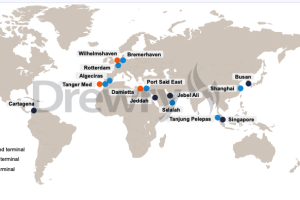Ocean Alliance faces notable ETS cost disadvantage
NewsSea-Intelligence found MSC’s network design nearly halves reportable sailing distances, giving it a cost advantage in ETS expenses over Ocean Alliance’s modest 7% reduction.
Drewry: The Gemini cooperation agreement between Maersk and Hapag-Lloyd will rely heavily on a small number of transhipment hubs to support its new network.

The success of the Gemini cooperation agreement between shipping giants Maersk and Hapag-Lloyd hinges significantly on the operational prowess of their select transshipment hubs, as explained by maritime consultancy Drewry.
This underlies the criticality of impeccable performance at these hubs to ensure the viability of the network. While acknowledging the world-class asset utilization at several terminals, Drewry emphasizes that maintaining such excellence is imperative for the venture’s success.
The Gemini cooperation agreement covers seven trades – Asia/USWC, Asia/USEC, Asia–/Middle East, Asia/Mediterranean, Asia/North Europe, Middle East-India/Europe and Transatlantic. The network comprises 26 mainline services supported by 32 dedicated shuttle routes.
The planned network streamlines the number of port calls in each region with the aim of reducing disruption. As a result, the loops are focussed heavily on ‘hub & spoke’ transhipment hubs supported by high-capacity dedicated shuttle loops that link the regional hubs with other gateway ports. In total, the mainline services will call at only 56 ports, with a further 29 ports served by dedicated shuttles. The services operated under the Gemini cooperation agreement will make extensive use of 15 hub ports (see map).

APMT operates terminals in eight of the selected ports, with Hapag-Lloyd having operational terminals in two of the ports while investing in a third.
“The high level of ownership across the hub port network provides the partners with a greater degree of control over operational management and investment plans – both of which will be key to the success of the hub-and-spoke strategy the partnership will employ,” Eleanor Hedland, Drewry’s
Several of the selected hub ports are already world leaders in terms of operational performance – APMT’s facilities in Tanger Med are both handling over 2,000 teu per metre of quay and more than 200,000 teu per crane, as is APMT Salalah. Tanjung Pelepas, Singapore, East Port Said and Algeciras – all of which handle high levels of transhipment – also rank highly in Drewry’s annual survey of terminal performance.
Capacity expansion projects across the network are also well advanced at the hub ports where utilisation levels are high. The pipeline of investments is spread across physical expansion of terminal assets (e.g. Rotterdam, East Port Said, Tangier MedPort), upgrade of capability to handle ULCVs (e.g. Bremerhaven, Salalah) and automation /digitalisation initiatives (e.g. Wilhelmshaven, Shanghai).
While the use of high-capacity dedicated shuttle services will facilitate efficient use of yard space at the hub ports, any repeat of the supply chain disruption seen in 2021-22 will put the Gemini network strategy under extreme pressure. The hub ports will need to provide sufficient buffer storage to make up for any mainline or feeder vessel delays.